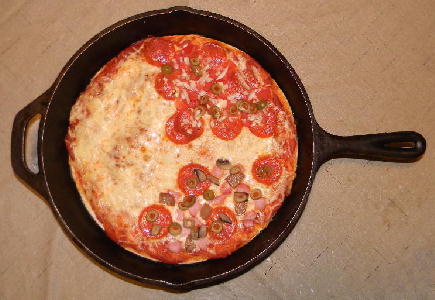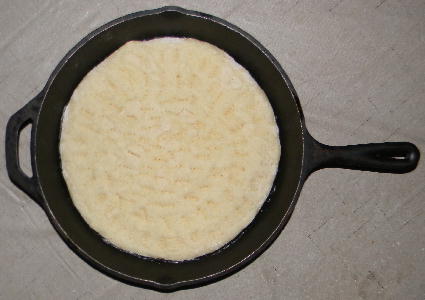

































 If you make your own homemade pizzas, then you can create pizzas that appeal to everyone who will be eating it. The pan pizza on the right was divided into thirds because each person eating the pizza had their own preferences. One person did not want any toppings, and two people wanted their own unique combination of toppings. Therefore one-third of the pizza was dedicated to each person, and that person decorated their third of the pizza exactly the way they wanted it. When it was sliced, each person received one-third of the pizza and each person cut their third into three equal slices for easy eating. Therefore the pan pizza in the picture was sliced into nine equal pieces. The same concept can be used for two people, three people, four people, five people, or six people. Or you can make two pizzas and allocate them to each person based on how much pizza each person wants. (Note: The cast iron skillet in the picture has a bottom diameter of 11 inches and a top diameter of 13 inches.)
If you make your own homemade pizzas, then you can create pizzas that appeal to everyone who will be eating it. The pan pizza on the right was divided into thirds because each person eating the pizza had their own preferences. One person did not want any toppings, and two people wanted their own unique combination of toppings. Therefore one-third of the pizza was dedicated to each person, and that person decorated their third of the pizza exactly the way they wanted it. When it was sliced, each person received one-third of the pizza and each person cut their third into three equal slices for easy eating. Therefore the pan pizza in the picture was sliced into nine equal pieces. The same concept can be used for two people, three people, four people, five people, or six people. Or you can make two pizzas and allocate them to each person based on how much pizza each person wants. (Note: The cast iron skillet in the picture has a bottom diameter of 11 inches and a top diameter of 13 inches.)| Thin | Medium | Thick | Deep Dish | |
| Crust Thickness (pre-rise) | 3/16 inch | 1/4 inch | 3/8 inch | 1/2 inch |
| Crust Ingredients: | ||||
| yeast (not instant rise) | 1 pkg. | 1 pkg. | 1 pkg. | 1 pkg. |
| warm water, 110°F | 1/2 c. | 3/4 c. | 1 c. | 1 c. |
| bread flour | 1 1/2 c. | 2 1/4 c. | 3 c. | 3 1/4 c. |
| granulated sugar | 2 1/4 tsp. | 3 tsp. | 3 3/4 tsp. | 4 tsp. |
| iodized salt | 1/2 tsp. | 3/4 tsp. | 1 tsp. | 1 tsp. |
| vegetable oil | 3 tsp. | 4 tsp. | 5 tsp. | 5 1/3 tsp. |
| Baking Information: | ||||
| cornmeal, for dusting pan | 1 1/2 T. | 2 T. | 2 1/2 T. | None |
| oven temperature | 450°F | 450°F | 450°F | 500°F |
| minutes pre-bake crust | 2 | 3 | 4 | 5 |
| minutes baking pizza | 10 - 12 | 12 - 15 | 13 - 16 | 12 - 14 |
| Pizza Pan Data: | 10-inch | 12-inch | 14-inch | 16-inch |
| square inches | 78.5 sq.in. | 113.1 sq.in. | 153.9 sq.in. | 201.1 sq.in. |
| number of slices | 6 slices | 8 slices | 12 slices | 16 slices |
| square inches / slice | 13.1 sq.in. | 14.1 sq.in. | 12.8 sq.in. | 12.6 sq.in. |
| Toppings: | ||||
| Pizza Sauce | 1 c. | 1 1/2 c. | 2 1/8 c. | 3 c. |
| Shredded Cheese | 2 c. | 3 c. | 4 1/4 c. | 6 c. |
 Pizza Crust Thickness: There is no standard for the final thickness of a pizza crust. Pizza crust thickness depends on how the dough is kneaded, and how long the dough is allowed to rise at each step in the process, and how the dough ball is made into a flat pizza crust (machine rollers, hand rolling pin, hand flattening, or tossing in the air). Medium thickness pizza crusts made by different restaurants will not be of the same exact average thickness and the thickness of those crusts can vary by as much as 25% from one restaurant to the next. However, this thickness is usually not visually obvious because the average medium pre-rise crust is 0.25 inches thick with a range between 0.20 inches to 0.30 inches. The above recipe will make a 12-inch pizza crust that will be about 15% thicker than the average restaurant pizza crust of the corresponding thickness. It will make a 14-inch pizza crust that will be about 15% thinner than the average restaurant pizza crust of the corresponding thickness.
Pizza Crust Thickness: There is no standard for the final thickness of a pizza crust. Pizza crust thickness depends on how the dough is kneaded, and how long the dough is allowed to rise at each step in the process, and how the dough ball is made into a flat pizza crust (machine rollers, hand rolling pin, hand flattening, or tossing in the air). Medium thickness pizza crusts made by different restaurants will not be of the same exact average thickness and the thickness of those crusts can vary by as much as 25% from one restaurant to the next. However, this thickness is usually not visually obvious because the average medium pre-rise crust is 0.25 inches thick with a range between 0.20 inches to 0.30 inches. The above recipe will make a 12-inch pizza crust that will be about 15% thicker than the average restaurant pizza crust of the corresponding thickness. It will make a 14-inch pizza crust that will be about 15% thinner than the average restaurant pizza crust of the corresponding thickness.
